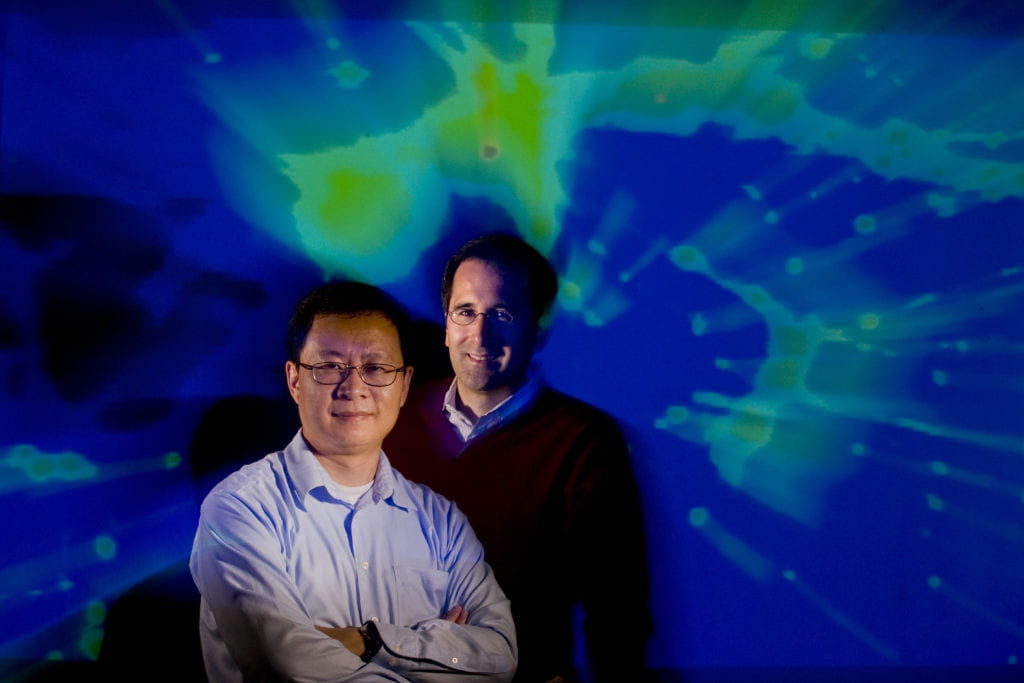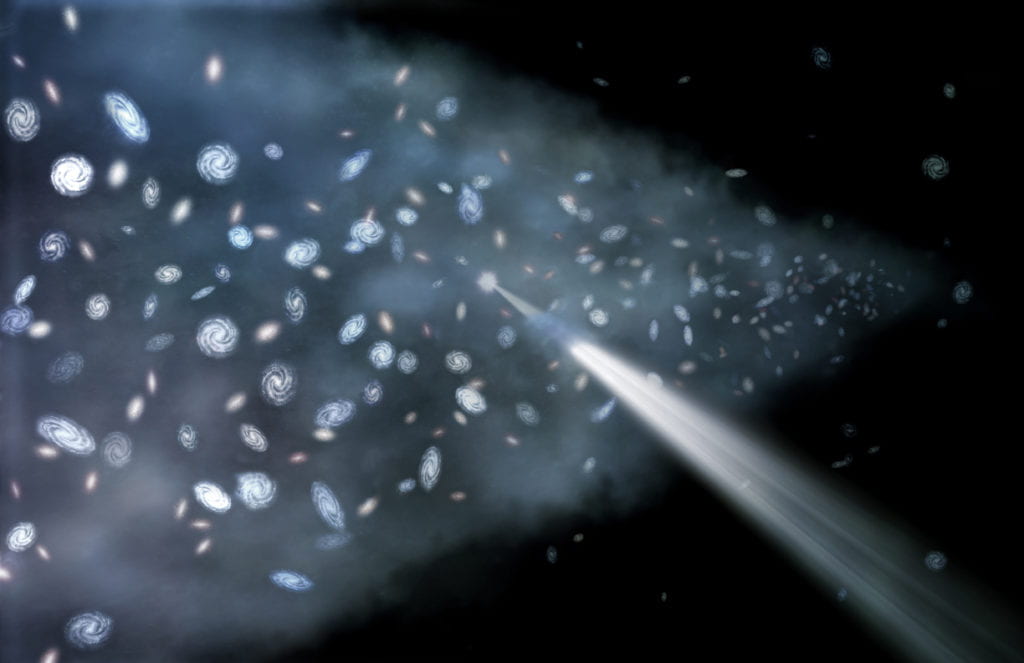New windows into space
Researchers in UC Irvine’s Center for Cosmology are opening new windows into space and finding lost matter and bright galaxies.
Technology is opening new windows into outer space, and UC Irvine scientists are eagerly looking through. Using data obtained from X-ray observations and deep-space telescopes, researchers in the School of Physical Sciences’ Center for Cosmology have located missing matter and clarified the origins of the brightest galaxies.
“These two studies demonstrate the breadth of our observational work and the great diversity of skills and creativity in the department,” says James Bullock, associate professor of physics & astronomy and director of the Center for Cosmology. “Between the X-rays, which are very short wavelengths, and the Herschel telescope, which collects data at long, infrared wavelengths, we’re utilizing a full expanse of the electromagnetic spectrum to explore the universe. It’s pretty exciting.”
X-ray detection solves mystery of missing matter: Using NASA’s Chandra X-ray Observatory and the European Space Agency’s XMM-Newton X-ray satellite, astronomers have discovered a vast reservoir of intergalactic gas about 400 million light years from Earth – the strongest indication yet that the universe’s missing matter is in an enormous web of hot, diffuse gas.
This missing matter – which is different from dark matter – is composed of what astronomers call baryons. These are chiefly the familiar protons and neutrons that make up humans, the Earth, stars and visible parts of galaxies, says Taotao Fang, UCI physics & astronomy researcher and lead author of the study, published in the May 10 issue of The Astrophysical Journal.
Measurements of distant gas clouds and galaxies have provided a good estimate of the amount of this “normal” matter present when our universe was only a few billion years old.
However, an inventory of the much older areas of the universe turned up only about half as much normal matter. This is referred to as “the missing-matter problem,” and scientists have struggled to explain it. Fang’s study supports theories that the missing matter might be part of a field of gas called the Warm-Hot Intergalactic Medium that scientists believe was left over after the formation of galaxies and later enriched by elements blown out of galaxies.
“Evidence for the WHIM is really difficult to find because this stuff is so diffuse and easy to see right through,” Fang says. “This differs from many areas of astronomy where we struggle to see through obscuring material.”
To look for the WHIM, researchers examined X-ray observations of a rapidly growing supermassive black hole known as an active galactic nucleus. This AGN, which is about 2 billion light years away, generates immense amounts of X-ray light as it pulls matter inward.
Lying along the line of sight to this AGN, at a distance of about 400 million light years, is the so-called Sculptor Wall, a large, diffuse structure stretching across tens of millions of light years. It contains thousands of galaxies and was suspected of harboring a significant quantity of WHIM. If so, its WHIM would absorb some of the X-rays from the AGN as they made their way to Earth.
Using new data and previous observations, Fang and his colleagues clearly detected the absorption of X-rays by oxygen atoms. The characteristics of the absorption were consistent with the distance of the Sculptor Wall as well as the predicted temperature and density of the WHIM.
“Having good detections of the WHIM with two different telescopes is really a big deal,” says study co-author David Buote, UCI associate professor of physics & astronomy whose lab is continuing the work. “This gives us a lot of confidence that we have truly found this missing matter.”
Bright galaxies cluster in regions with lots of dark matter: For more than a decade, astronomers have been puzzled by bright galaxies in the distant universe that appear to be forming stars at phenomenal rates. What prompted the prolific star creation, they wondered. And what kind of spatial environment did these galaxies inhabit?
Now, using a super-sensitive camera/spectrometer on the Herschel Space Observatory, astronomers – including a UCI team led by Asantha Cooray – have mapped the skies as they appeared 10 billion years ago. The UCI scientists discovered that these glistening galaxies preferentially occupy regions of the universe containing more dark matter and that collisions probably caused the abundant star production.
“Thanks to the superb resolution and sensitivity of the SPIRE [Spectral & Photometric Imaging Receiver] instrument on Herschel, we managed to map in detail the spatial distribution of massively star-forming galaxies in the early universe,” says Cooray, associate professor and Chancellor’s Fellow in physics & astronomy. “All indications are that these galaxies are … crashing, merging and possibly settling down at centers of large dark-matter halos.”
This information will enable scientists to adapt conventional theories of galaxy formation to accommodate the strange, star-filled versions.
The European Space Agency’s Herschel observatory carries the largest astronomical telescope operating in space today; it collects data at far-infrared wavelengths invisible to the naked eye.
One of three cameras on Herschel, SPIRE has let Cooray and his colleagues survey large areas of the sky – about 60 times the size of the full moon – in the constellations of Ursa Major and Draco. The UCI team also included Alexandre Amblard, project scientist in physics & astronomy; Paolo Serra, postdoctoral fellow; and physics undergrads Ali Khostovan and Ketron Mitchell-Wynne – the youngest participants in the international consortium.
The data analyzed in this study was among the first to come from the Herschel Multi-Tiered Extragalactic Survey, the space observatory’s largest project. UCI is one of only four U.S. educational institutions involved in HerMES. Seb Oliver, a University of Sussex professor who leads the survey, calls the findings exciting.
“It’s just the kind of thing we were hoping for from Herschel,” he says, “and was only possible because we can see so many thousands of galaxies. It will certainly give the theoreticians something to chew over.”
The study will appear in a special issue of Astronomy & Astrophysics dedicated to the first scientific results from Herschel. The project will continue to collect images over larger areas of the sky in order to build up a more complete picture of how galaxies have evolved and interacted over the past 10 billion years.

